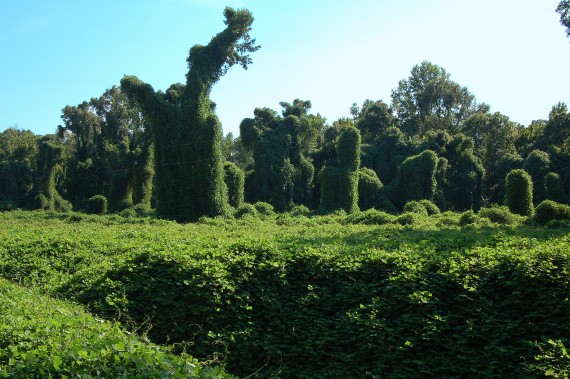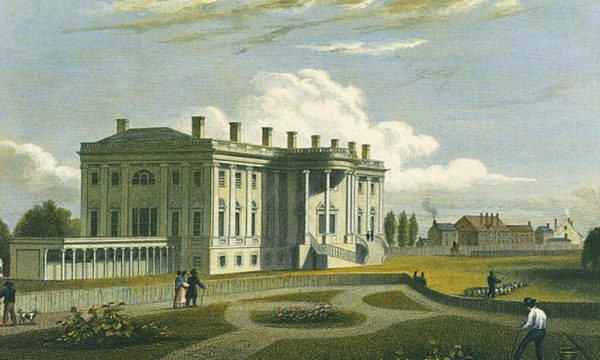“Cotton isn’t king in the South anymore … Kudzu is king!”
Channing Cole, Atlanta Constitution
The mysterious disappearance of England’s first settlement in North America, Sir Walter Raleigh’s “Lost Colony” which was established in 1584 on Roanoke Island in what is now North Carolina, may never be solved, but it is safe to assume that starvation must have played a part in the tragedy. Again, in 1607, the lack of food almost wiped out the second English colony in the New World, Jamestown in Virginia. Nevertheless, within a century the South had become a veritable cornucopia of not only all manner of foodstuff, but virtually all of America’s major cash crops and export products, such as indigo, rice, sugar, timber, tobacco, and what was to become the king of them all . . . cotton.
The growing of cotton began in central Asia over seven thousand years ago, and it was an important crop in several countries of the ancient world, including China, Egypt and Persia, as well as another variety of the plant in parts of pre-Columbian South and Central America. Cotton seeds from Mexico and Peru were first brought to North America in 1556 by the Spanish colonists in Florida, and the plants flourished in that area’s warm, humid climate. A century later cotton was introduced into the English colonies of Georgia and South Carolina, and by the middle of the 18th Century small quantities of cotton were already being shipped to English textile mills. At the end of that century, however, Eli Whitney’s cotton gin revolutionized the industry in the South, and the few thousand bales of cotton that were produced there in 1790 grew to over 100,000 bales within a decade. In dollar terms, a crop that was valued at less than $100,000 in colonial America became a $10 million enterprise in the United States by the early 19th Century. By 1860, the South was producing over five million bales of cotton worth over half a billion dollars, or about $15 billion in today’s terms, and Southern cotton dominated the world market.
Needless to say, during the War Between the States cotton production became a fraction of what it was before the War, falling to less than 300,000 bales by 1864. Immediately after the War, however, production began to rise again, and within five years the figure was back to over four million bales. While other crops were, of course, grown in South, and the boll weevil infestation from Mexico at the end of the 19th Century greatly reduced production, cotton still dominated Southern agriculture well into the 20th Century. It was primarily this single-crop industry that eventually caused irreparable damage to the area’s farmland, particularly by depleting the area’s soil of its natural nutrients, and then though soil erosion by which, over the years, vast amounts of the area’s irreplaceable topsoil were washed into the South’s waterways. Had crop rotation techniques been used in cotton farming at an early stage perhaps the damage would have been far less, but that practice came a century too late.
Various types of rudimentary crop rotation methods had been utilized throughout the world for thousands of years, and even in the Bible the Book of Leviticus speaks of the “Sabbath of the land” in which the fields should remain unplanted every seventh year. However, it was not until the 18th Century that the first truly effective “four-field” form of crop rotation was developed by the English agriculturalist, Charles Townsend, and that development ultimately led to Great Briton’s Agricultural Revolution. The concept quickly spread to Germany and the overworked soil in other European countries. In America though, particularly in the South and Midwest, there seemed to be little need for such conservation measures since there were always boundless fresh acres to be made available for cultivation as the new nation continued its ever westward expansion.
By the end of the 19th Century, however, the unrestricted planting of crops such as cotton eventually began to take its toll. In the early part of the following century various voices in the South began calling for more prudent methods of farming, particularly in relation to cotton, in order to save the land from further soil depletion and erosion. One of those giving such advice was a former Missouri slave who had risen to become one of the South’s leading agronomists and botanists, George Washington Carver of Georgia. Carver, who became world famous for his work in developing numerous uses for the humble Georgia peanut, not only advocated letting the depleted cotton fields have periodic times of rest, but to plant other soil-enriching crops in place of cotton from time to time, such as peanuts, soybeans, and yams. While such methods did greatly help to restore the agricultural health of the land, the ever-growing problem of soil erosion in the South still remained. During the early 1930s a new voice was then heard, that of Hugh Hammond Bennett of North Carolina, known as the “father of soil conservation.”
Bennett had joined the U. S. Department of Agriculture in 1903 as a member of the Soil Survey Division, and thirty years later he was instrumental in having the Soil Erosion Service established in the Department of the Interior. In 1935, the new agency was moved to the Department of Agriculture and renamed the Soil Conservation Service, with Bennett being placed in charge. There he was referred to as “the Chief” or “Big Hugh” and he soon instituted a variety of conservation measures throughout the South, including crop rotation, contour plowing and strip cropping, as well as the method of Asian rice farming known as terracing in which different levels of land are created for planting. He also introduced another idea from Japan to counter soil erosion, the planting of the rapidly-growing ground cover called kudzu. To carry out this project, Bennett not only mobilized the New Deal’s military-style workforce, the Civilian Conservation Corps, to conduct the planting of kudzu throughout the South, but he also had the federal government allocate funds to pay Southern farmers eight dollars an acre to plant the vine on their own land. In all, well over a million acres of land in the South were covered with kudzu within a few years.
The kudzu vine, known as “kuzu” in Japan, was first brought to America as one of the ornamental plants in the garden of the Japanese Pavilion at the Philadelphia Continental Exposition of 1876, and a decade later the Japanese vine was exhibited in Louisiana at the New Orleans Exposition. The plant’s broad, luxuriant leaves and fragrant purple flowers, as well as its rapid growth, made the vine popular with a public that dubbed it the “porch vine,” and kudzu began to be widely used as an alternate shade plant to wisteria. Then, in the 1930s, when the plant’s other uses as both a protein-rich forage crop and an efficient, low-cost, means of controlling soil erosion were better known, another Georgian appeared to take his place as a leading advocate of kudzu, Channing Cope, the farm editor of the Atlanta Constitution, who termed it the “miracle vine.” Cope also extolled the virtues of kudzu on the front porch of his home in Covington, Georgia, from where his programs were aired over station WSB in Atlanta during the early 1940s, as well as personally traveling throughout the South to promote the establishment of his “Kudzu Clubs.”
By the mid-1940s, however, even though Japan had just been defeated in World War Two, the other insidious Japanese invasion was still very much in progress in America, the massive, out-of-control advance of kudzu. Not only was the vine now covering vast areas of the South, but it was beginning to make its way northward into Pennsylvania, New York, Ohio, and even further upward into Canada at a rate reaching nearly a foot a day during the plant’s growing season and about sixty feet a year. In 1953, the Department of Agriculture finally realized the potential ecological danger being posed by the invasive plant, and, much to the disgust of people like Channing Cole, discontinued the introduction of kudzu as a soil-erosion control agent. The total rate of kudzu’s growth at one time was estimated at about 150,000 acres a year, but the the U. S. Forest Service now claims that the annual rate is only about 2,500 acres. During World War Two, the U. S. military also planted kudzu in northern Australia and various islands in the South Pacific as camouflage, as well as at a few locations in Italy, and it is still a major problem in all those areas.
In its deadly advance, kudzu can cover and suffocate whole forests by reaching heights of almost a hundred feet and completely cutting off all sunlight to both the trees and undergrowth, as well as entirely blanketing vacant buildings and abandoned vehicles in a matter of a few years. Most herbicides have little real effect on the plant, and kudzu even thrives on some types of weed killer. Furthermore, the few chemical agents that are effective against kudzu take anywhere from five to ten years to eradicate the vines completely. Actually, the most effective methods of defeating kudzu are to manually cut off the head of the root or merely allow such animals as goats and sheep to graze on the plants. Of course, some Southerners have just adopted a philosophic attitude towards “the plant that ate the South,” and made it a part of Southern folklore with such wry advice as, “If y’all want to plant kudzu, just drop it and run . . . but do it at night so the neighbors don’t see you doing it.” There are also tales of hitchhikers in the South vanishing along kudzu-lined roads, while others advise motorists to keep the car windows closed when driving on such highways in order to keep the kudzu out. Even the noted Southern poet, James Lafayette Dickey of Georgia, who had a rather different type of Asian experience as a bomber pilot over Japan during World War Two, wrote an often quoted poem about the pervasive plant which he simply called “Kudzu,” part of which goes:
“In Georgia, the legend says
That you must close your windows
At night to keep it out of the house.
The glass is tinged with green, even so.”







